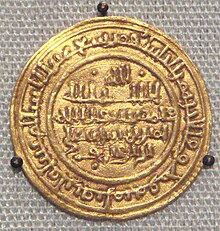Maravedí
The maravedí , also known as the marabotin as a gold coin , was a coin and currency of account in use in Spain for several centuries ; it was the longest-running currency unit in Spain. Its history began in the 12th century with the first minting as an originally mint-free gold coin of around 3.8 grams and led through numerous devaluations and the temporary use as pure billing currency up to small copper coins in 1854.
etymology
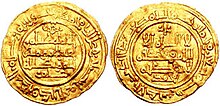
The term is derived from the name of the Almoravids ( Arabic المرابطون, DMG al-Murābiṭūn , singularمرابط / Murābiṭ ) well-known Berber dynasty who first created this coin in al-Andalus (الأندلس / al-Andalus ) as a gold coin. Initially the term Morabatín was used, which later became maravedí . The word Maravedí has three different plural forms as a special feature: Maravedís is the usual plural form, Maravedíses follows the form often used for nouns with the ending -í . Maravedíes is a rarely used plural form.
Gold dinars of the Almoravids up to the 12th century
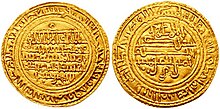
When conquering parts of the Iberian Peninsula in the 8th century, the Moors also brought their own coin system with them. This was applied in al-Andalus , including the caliphates established in the 10th century, the Taifa kingdoms , and in the emirate of Granada until the conclusion of the Reconquista in 1492. By the 12th century, the gold dinars had also been recognized as a means of payment in Christian Spain. The trading partners of the Moors in Christian Spain and the rest of Europe demanded payment in gold coins. The marabot of the Almoravids and the double dinar of the Almohads were known and accepted as currency throughout Europe until the 12th century.
Spanish gold maravedís from the 11th to 13th centuries
The Arab maravedí were later imitated by the Christian kings of northern Spain. Such gold coins exist from Castile from Alfonso VIII , from León from Kings Ferdinand II and Alfons IX. , and as Morabitinos by the kings of Portugal. The coin weights were retained, so that the coinage was not based on the Carolingian coin system like almost all European kingdoms . One maravedí was the equivalent of one Arabic dinar.
Castile

As a result of the transition of rule from the Almoravids to the Almohads and the collapse of the Taifa kingdoms , there was a shortage of gold coins in Castile. Under Alfonso VIII (reigned 1158–1214) it was therefore decided in 1172 to mint its own coins. The gold dinars struck by Alfonso VIII in Castile were also called "Alfonsine Marabotin" to distinguish them from those of the Almoravids. The first coins of Castile struck in Toledo , like those of the Almoravids, were only inscribed in Arabic. The design of the coins meant that they could only be struck in Toledo because of the required knowledge of Arabic script. This made the city the most important mint in Spain for centuries. The use of the Arabic script and the unchanged coin weights primarily had the function of gaining widespread acceptance of the means of payment.
Alfonso VIII nevertheless also used the design of the coins as a means of representing religious and political understanding. The coins struck later also have Arabic lettering, but there is a cross as a Christian symbol at the top of the medallion . Below this is the reference to the imam as the highest religious authority, as with the coins of the Almoravids without mentioning the name, but here as a reference to the Pope. In the bottom line the letters ALF are shown, as a name reference to the secular ruler and minting Alfons VIII. The inscription is a commitment to the Christian faith. While the coins of the Almoravids quote the first part of the Shahāda at this point , the coins of Alfonso VIII mention the Trinity and declare that only the baptized is rewarded with eternal life .
The inscription on the reverse refers to the king in Arabic script. While the coins of the Almoravids designate the respective ruler as Amīr al-Muslimīn , Alfonso VIII chose the designation Amīr al-Qatuliqīn , "Prince of the Catholics". This is followed by the designation of Alfonso VIII as Alfuns ben Sanǧu , "Alfons, son of Sancho", combined with the request to God for the protection of the monarch. The inscription on the reverse gives the minting location Toledo and the year 1224. In contrast to the Almoravid coins, where a year was given in the Islamic calendar, the coins of Alfonso VIII show the year after the Spanish era . The indication of the year is unusual for medieval coins issued by Christian rulers and only became common in the 16th century. The year on the coin means 1186 AD in the Christian calendar, other coins show the converted figures 1187 and 1213. The Alfonsine Maravedís became the preferred gold coin in the Christian part of the Iberian Peninsula because of their status as the official gold currency and their uniform gold content. Minting of these coins was until the reign Henry I continued.
Leon
Ferdinand II of León (reigned 1157–1188) also had Maravedí struck after the first coins by Alfonso VIII of Castile, whose weight and gold content match the coins of Castile. The obverse of the coins shows the king's head, the reverse shows the mounted king with a raised sword. The coins do not bear any reference to the Moors. They were referred to as the second Maravedí alfonsí , as Maravedí de busto , Maravedí nuevo or Maravedí leonés . Very few pieces of these coins have survived.
| Surname | Alternative names | time | Remarks |
|---|---|---|---|
| Maravedí | Maravedí, marabotin, Alfonsine maravedí | 1172 | Castile, Alfonso VIII., No images except the cross, Arabic inscription with a Christian reference |
| Maravedí | Maravedí, marabotin, Alfonsine maravedí | 1186, 1187, 1213 | Castile, Alfonso VIII., No images except the cross, Arabic inscription with a Christian reference |
| Maravedí | Maravedí, Marabotin, Maravedí de busto, Maravedí nuevo, Maravedí leonés | late 12th century | León, Ferdinand II., Bust Ferdinand II., Back of the mounted king, no Arabic inscription |
Other Spanish "Maravedí"
There are other coins from the Spanish Middle Ages, which in older literature occasionally belong to the Maravedí or are regarded as their direct predecessors. Alfonso VI von León had silver dinars and half dinars struck around 1085 after the capture of Toledo. These coins were labeled with the Islamic creed “There is no God but God”, a reference to the year the city was handed over and Toledo as the place of manufacture. In 1157, under Ferdinand II of León (reigned 1157–1188), silver denarii were struck, Leones showing his bust and a lion ready to jump.
Maravedís in the 13th to 14th centuries
Under Ferdinand III. (ruled from 1217 to 1230 Castile, until 1252 Castile and León) gold coins weighing the Muslim half-dinar were struck, which were given the designation Maravedí bueno , but had only three fifths of the weight of an Alfonsine Maradeví. After this coin came into circulation, the Muslim dinar was called the “double maravedí ” or dobla , from which the name “ doubloon ” goes back. The Alfonsine Maravedí, also known as Maravedí viejo , Maravedí castellano or Alfonsí , remained the most important gold coin in circulation until the reign of Alfonso X. In addition, Ferdinand had a silver coin, the León, and the Pepiones struck, 180 of which went to a Maravedí bueno .
In 1252, Alfonso X of Castile and León (ruled 1252–1284) abolished the Silver León Ferdinands and the Pepiones . He introduced the silver Maravedís blancos or Maravedís de los Burgaleses , six of them corresponded to an old gold Maravedí. These coins were later given the other names Maravedís viejos , Moneda viejo or Moneda blanca . After only six years Alfons moved the money out of circulation and replaced it with Billonmünzen with the names Maravedíses negros , maravedis de los Prieto or Prieto , known as coins until the late 15th century I. Isabella and Ferdinand II. Were minted . The introduction of an already by Ferdinand III. prepared new gold currency, which was based on the double dinar of the Almohads and took over the coin weight from him, was the end of the maravedí as gold coin. At the same time, the new currency was no longer calculated on the Roman Libra, but on the Cologne mark . The use of the maravedí as a unit of account goes back to this coin reform, in which a gold doubloon was assigned a value of 35 maravedí.
In 1281 Alfonso X introduced a second series of “white” coins, the blancos segundos or maravedís novenes . Four maravedís novenes corresponded to a maravedí de los Prietos , ten maravedís novenes to a maravedí de los Burgaleses , or sixty maravedís novenes to an old gold maravedí. These coins continued to be minted during the 13th century, and under John I (reigned 1379–1390) they were referred to as "current Maravedís", compared to the old Maravedís de los burgaleses , also known as "Maravedís of good currency".
Among the coins Alfonso X came by his successor in 1286 Sancho IV. (R. 1284-1295) introduced Coronado , later Cornado called, six of which a "Burgalese" corresponded. More important was the introduction of a series of new gold coins by Alfonso XI. (r. 1312-1350). He created the Doblas , later also called Castellanos , a gold coin initially weighing 48 Doblas from 989 gold on a Cologne mark, which took on the role of Maravedí in minting. During the reign of Peter I of Castile and León (r. 1350-1369), the real de Plata was introduced with 66 reales to one Cologne mark, a maravedí was equivalent to 1 ⁄ 34 real or 1 ⁄ 30 Castellano.
There were also coins of two, four, six and eight maravedí, the value of which was often changed by counterstamps . Under the reign of Henry III. (ruled 1390–1406) there were finally 132 different coins in the kingdom. The lack of small coins for everyday use and the greater appreciation for gold coins from France and other countries meant that the Spanish gold coins were gradually exchanged for small foreign coins and the state's wealth dwindled. One result was that everyday business was mainly carried out with foreign or illegally produced copper coins.
Maravedís in the 15th and 16th centuries
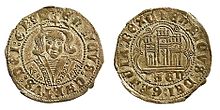

In the 13th and 14th centuries, coinage in Castile and León had fallen into anarchy. During this time, the value of the Maravedí, which is important for the population, sank enormously. In 1312 a Cologne mark was still charged at 130 Maravedí, and due to the reduced silver content in 1474 it was already 2,210 Maravedí. There were more than 150 legal and countless illegal mints, the gold content of the coins went from 23.5 carats down to 7 carats, the silver currency fared similarly. There were eight classes of billon coins, which represented different denominations of the real from 1 ⁄ 6 to 1 ⁄ 58 and existed in different multiples or parts. Henry IV tried to intervene and reduced the number of mints to six. He reformed the currency and declared the old doubloon under the names Enrique , Castellano or, with double weight, Dobla castellana to the gold standard . The real de la Plata was the silver currency, and the blanca or media blanca (half blanca), worth a third or sixth of a maravedí, the small billon coins. The coin reforms of Heinrich IV. Should make the maravedí, which until then was primarily a designation for certain coins, the generally used unit of account. However, Henry IV did not succeed in getting his ideas through.
The rule of Isabella I and Ferdinand II (ruled 1474–1504) brought eleven new coin orders by the end of the century. The 1475 confirmed the coinage of Heinrich IV and set the value of a silver real at 30 maravedí. Heinrich's standard gold coin Dobla Castellana became an Excelente . The Excelente had a value of 870 Maravedí, corresponding to the Enrique or Castellano 435 Maravedí. The Dobla de la Banda , which was no longer struck but was still in circulation, had a lower gold grade and its value was set at 335 maravedí.
From 1480, the Real de la Plata was set to a value of 31 maravedí at 3 blanca , mainly as a result of a shortage of materials . For the majority of the population, only the small coins were of importance and so the Blancas of Henry IV continued to be in circulation, as no new mintings were initiated in 1475. These small coins gradually disappeared and were replaced by foreign coins in everyday life.
In 1497, Isabella I of Castile and Ferdinand II of Aragon replaced the Excelente with the Venetian ducat as the new gold coin, as this was more widespread in the Christian kingdoms and principalities. The minting of half, whole and double ducats was ordered, with the double ducat being the most frequently minted gold coin. The new gold ducat was named Excelente or Excelente de la Granada , based on the old doubloon , the naming alluded to the handover of the city of Granada by the Moors five years earlier . The new Excelente had a value of 375 maravedí. The real de la Plata was confirmed as the silver currency, one real now corresponded to 34 maravedís. The Maravedí was no longer divided into three, but into two Blancas .
Forty years later (1537) the ratio of the maravedí to the gold currency was changed, there were now 350 maravedís per ducat, and from 1566 400 maravedís. The ratio to silver remained unchanged both times. The maravedí was now the unit of account in the everyday life of the population, although there were no coins with this name. If settlements were made in real or ducat, a conversion into maravedí based on the fixed ratios of gold, silver and billon currencies was possible without any problems. The goal of withdrawing the circulating illegal and foreign small coins in favor of the new change, however, was not achieved.
Maravedís in the 17th to 18th centuries
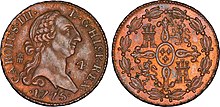
In the 17th and 18th centuries there was a dramatic increase in the issue of billon coins, so that their value quickly declined. The maravedí was devalued by 10% compared to the escudo in 1609, so that it was now worth 440 maravedí. At the same time, high surcharges were applied to the fixed conversion value on gold and silver coins, and large numbers of these coins then disappeared from circulation. In 1625, such surcharges of more than 10% were forbidden with severe penalties; the limits were raised to 25% in 1636 and to 50% in 1641. From 1642 the real was divided into 45 maravedí. By 1680 the gold doubloon was worth 110 reals in billon coins, and the silver real was worth 29 reals in billons.
From 1686, the Escudo de la Plata was introduced as a new coin, which provided for a 25% reduction in silver weight without taking the existing coins out of circulation. As a result, two silver currencies now existed side by side. A new billon currency was also created without abolishing the old billon currency. Up until the 19th century, coin reforms were repeatedly carried out that affected the purity and weight of gold and silver coins. Their goal of ending the constant appreciation of the gold and silver currency compared to the copper currency was not achieved with any measure.
| Surname | Maravedís | Introduction (kings) | Remarks |
|---|---|---|---|
| Blanca | ½ maravedí | 1492 (Ferdinand II and Isabella I) | |
| Cuartillo | 8 ½ maravedis | 1566 (Philip II) | |
| Cuarto | 4 maravedís | 1566 (Philip II) | |
| Medio | 2 maravedís | 1566 (Philip II) | |
| Blanco | ½ maravedí | 1566 (Philip II) | |
| Cuarto | 4 maravedís | 1599 (Philip II) | pure copper |
| Ochavo | 2 maravedís | 1599 (Philip II) | pure copper |
| Molino | 16 maravedís | 1660 (Philip IV) | the last billon coins, subsequent issues were made of copper |
Late Maravedís in the 19th century

All coin reforms since 1497 had left the relationship between the silver real and the Maradeví unchanged. In 1834, the equivalent of the silver real was reduced from 34 to 32 maravedí, while the silver content of the real was reduced to 875 ⁄ 1000 . A second law aimed to stop the circulation of French coins. These measures did not produce the desired results either. In 1847 the decimal system was decided for the real with a real at 100 centimos, since 1859 only the decimal system adopted by France has been in force in Spain. The last time the maravedí was issued as a coin was in 1854, with a portrait of Queen Isabella II of Spain. At this point in time, as part of the changeover from the Spanish currency to the decimal system , Centimos were already in circulation. The 8 maravedí coins with the year of issue 1855 or 1858 are forgeries.
Maravedís outside Spain
With the Real de Plata , the Maravedí also found its way into Spanish overseas possessions, where it became the unit of currency.
Hispaniola (16th century)
In the early 16th century, the Spaniards used bars and plates made of indigenous impure gold, into which they struck values according to the Spanish currency. Later, counterfeit Spanish gold coins circulated on a large scale, the main currency being the silver real. Around 1528 it was complained that the gold content of the peso d'Oro was only 19 carats or less, but 450 instead of 375 maravedí were given as the value for the coin. The lack of small coins, including the silver real, was repeatedly lamented until the mid-16th century. One problem was the difference in the valuation of the real, which was 34 maravedí in Spain but 44 maravedí in Hispaniola. A royal decree of 1538 stipulated 34 maravedí for one real, but by that time there were already very large quantities of reals in circulation. The new regulation meant that the minting of silver coins fell sharply, and the complaints about the "bad money of Hispaniola" continued until 1565.
Oran (North Africa, 17th century)
In the 17th century, the North African city of Oran was repeatedly occupied by Spain. In 1618 and 1691 local coins appeared with the crowned coat of arms of Castile and León and the inscription ORAN on the reverse . The coins were struck in Toledo and the currency denomination was the maravedí.
Isla Margarita (South America, 1810)
In 1810, Isla Margarita , today part of Venezuela, declared itself independent and shortly afterwards joined the former Spanish viceroyalty of New Granada . During this time, coins of 4 maravedí or medals were issued. On the front they show three men in a boat with the inscription MARGARITA PERLA PRECIOSA , on the back the inscription DA FX DIA 4 DE MAIO 1810 , with the number in the middle and surrounded by seven stars. Numismatic research has not yet been able to decide whether these are coins for four maravedí or just medals to celebrate May 4th as independence day.
The maravedí in everyday culture
In Miguel de Cervantes ' Don Quixote (published 1605 and 1613) the Maravedí is mentioned 13 times. At one point the eponymous hero ponders Arabic loanwords in Spanish that mostly begin with Al- and mentions Maravedí as one of only three Arabic-derived words that do not begin with Al- but end with -i .
The copper coins for two and four maravedí also had their own names in colloquial language. So the two were called Ochavo , and the four Cuarto . There were also names for coins that represented a fraction of a maravedí. A blanca was equal to half or third of a maravedí. A cornado , named after the crowned king as a coin image, was 1 ⁄ 6 maravedí. The maravedí, similar to the German “Groschen” or “Heller”, has entered a number of idioms by itself or with one of the names for its multiple. Kaiser Wilhelm II mentions him in the course of the financing of the military: "Because of this, the army did not get another maravedi, but only what the Minister of War requested and received for them according to the budget."
literature
- James Carson Brevoort: Early Spanish and Portuguese coinage in America , self-published, Boston 1885, Internet Archive , Online PDF, 1.0 MB, accessed February 20, 2014.
- Jon Edwards: Christian Córdoba: The City and Its Region in the Late Middle Ages , Cambridge University Press, Cambridge 1982, digitized , accessed February 19, 2014.
- José María de Francisco Olmos: El nacimiento de la moneda en Castilla. De la moneda prestada a la moneda propia . In: I Jornadas Científica sobre Documentación jurídico-administrativa, económico-financiera y judicial del reino castellano-leonés, siglos X-XIII , Universidad Complutense, Madrid 2002, pp. 303-346, ISBN 84-699-9442-5 , digitized , Online PDF, 2.7 MB, accessed February 20, 2014.
- Albert R. Frey: A dictionary of numismatic names, their official and popular designations . The American Numismatic Society, New York (NY) 1917, Internet Archive , Online PDF, 21.2 MB, accessed February 18, 2014.
- José Ángel Ortega Dato: Los dineros en El Quixote . In: Suma. Revista para la enseñanza y el aprendizaje de las matemáticas , Issue 52, 2006, pp. 33-40, ISSN 1130-488X .
- Josep Pellicer i Bru: La "quiebra del maravedí de oro", finalizando el reinado de Fernando III (1217-1230 / 1252) (Índice de nombres de moneda, pesos y medidas del libro de Roberto I. Burns SJ) . In: Documenta y Instrumenta , Volume 6, 2008, pp. 227-248, ISSN 1697-4328 .
- María Ruiz Trapero: Aportación de las fuentes epigráficas y numismáticas al conocimiento de la sociedad castellano-leonesa (siglos X-XIII) . In: I Jornadas Científica sobre Documentación jurídico-administrativa, económico-financiera y judicial del reino castellano-leonés, siglos X-XIII , Universidad Complutense, Madrid 2002, pp. 349-374, ISBN 84-699-9442-5 , digitized , Online PDF, 960 kB, accessed on February 22, 2014.
- Friedrich v. Schrötter et al. (Ed.): Dictionary of coinage. 2nd unchanged edition. de Gruyter, Berlin 1970, reprint 2012, ISBN 978-3-11-001227-9 (reprint of the original edition from 1930).
- William Arthur Shaw: The history of currency, 1252 to 1894 , Wilsons & Milne, London undated (1895), Internet Archive , Online PDF, 9.5 MB, accessed on February 20, 2014.
- Rainer Wohlfeil : Spain's history as reflected in coins and banknotes . DOBU scientific publishing house, Hamburg 2010, ISBN 978-3-934632-39-4 .
Web links
Individual evidence
- ↑ Antonio Orol: Las monedas en la época de La Celestina . In: NVMISMA , 52nd volume, number 231, 1992, pp. 65–71, here p. 71.
- ^ Eduard von Zambaur : Oriental Numismatics . In: Numismatic Journal , Volume 39/40, 1907, pp. 23–68.
- ^ A b c d e Jon Edwards: Christian Córdoba: The City and Its Region in the Late Middle Ages , p. 202.
- ↑ a b c d José Ángel Ortega Dato: Los dineros en El Quijote , p. 40.
- ↑ a b José María de Francisco Olmos: El nacimiento de la moneda en Castilla. De la moneda prestada a la moneda propia , p. 334.
- ^ Albert R. Frey: A dictionary of numismatic names, their official and popular designations , p. 143 (Lemma "Marabotins").
- ↑ María Ruiz Trapero: Aportación de las fuentes epigráficas y numismáticas al conocimiento de la sociedad castellano-leonesa (siglos X-XIII) , p. 368.
- ^ A b Albert R. Frey: A dictionary of numismatic names, their official and popular designations , p. 143 (Lemma "Maravedi").
- ^ Antonio Orol: Numismática castellano-leonesa . In: NVMISMA , 52nd volume, number 231, 1992, pp. 255–259, here p. 255.
- ^ Albert R. Frey: A dictionary of numismatic names, their official and popular designations , p. 143 (Lemma "Marabotin Alfonsin").
- ↑ a b José María de Francisco Olmos: El nacimiento de la moneda en Castilla. De la moneda prestada a la moneda propia , pp. 334-335.
- ^ Hermann Grotefend: Handbook of the historical chronology of the German Middle Ages and the modern times , Hahn'sche Hofbuchhandlung, Hanover 1872, pp. 23–24.
- ↑ José María de Francisco Olmos: El nacimiento de la moneda en Castilla. De la moneda prestada a la moneda propia , p. 336.
- ↑ a b José María de Francisco Olmos: El nacimiento de la moneda en Castilla. De la moneda prestada a la moneda propia , pp. 336-337.
- ↑ María Ruiz Trapero: Aportación de las fuentes epigráficas y numismáticas al conocimiento de la sociedad castellano-leonesa (siglos X-XIII) , p. 365.
- ↑ a b c José María de Francisco Olmos: El nacimiento de la moneda en Castilla. De la moneda prestada a la moneda propia , p. 337.
- ↑ a b José María de Francisco Olmos: El nacimiento de la moneda en Castilla. De la moneda prestada a la moneda propia , p. 338.
- ^ A b María Ruiz Trapero: Aportación de las fuentes epigráficas y numismáticas al conocimiento de la sociedad castellano-leonesa (siglos X-XIII) , pp. 355–356, pp. 364–365.
- ↑ a b Friedrich v. Schrötter et al. (Ed.): Dictionary of Coin Studies, S 367–368 (Lemma “Maravedi”).
- ↑ a b Josep Pellicer i Bru: La "quiebra del maravedí de oro", finalizando el reinado de Fernando III (1217-1230 / 1252) , p. 231.
- ^ A b c William Arthur Shaw: The history of currency, 1252 to 1894 , p. 321.
- ↑ a b José María de Francisco Olmos: El nacimiento de la moneda en Castilla. De la moneda prestada a la moneda propia , pp. 314-315.
- ↑ Antonio Orol: Las monedas medievales castellano-Leonesas . In: NVMISMA , 52nd volume, number 231, 1992, pp. 73-102, here p. 76.
- ^ William Arthur Shaw: The history of currency, 1252 to 1894 , pp. 321-322.
- ^ A b Antonio Orol: Numismática castellano-leonesa , p. 256.
- ^ A b William Arthur Shaw: The history of currency, 1252 to 1894 , p. 322.
- ^ María Ruiz Trapero: Aportación de las fuentes epigráficas y numismáticas al conocimiento de la sociedad castellano-leonesa (siglos X-XIII) , pp. 356-357.
- ↑ María Ruiz Trapero: Aportación de las fuentes epigráficas y numismáticas al conocimiento de la sociedad castellano-leonesa (siglos X-XIII) , p. 356.
- ↑ a b c William Arthur Shaw: The history of currency, 1252 to 1894 , p. 323.
- ↑ María Ruiz Trapero: Aportación de las fuentes epigráficas y numismáticas al conocimiento de la sociedad castellano-leonesa (siglos X-XIII) , p. 367.
- ^ A b Albert R. Frey: A dictionary of numismatic names, their official and popular designations , p. 198 (Lemma "Real").
- ^ Albert R. Frey: A dictionary of numismatic names, their official and popular designations , p. 42 (Lemma "Castellano").
- ^ A b William Arthur Shaw: The history of currency, 1252 to 1894 , p. 324.
- ^ William Arthur Shaw: The history of currency, 1252 to 1894 , p. 24.
- ^ William Arthur Shaw: The history of currency, 1252 to 1894 , p. 15.
- ^ A b William Arthur Shaw: The history of currency, 1252 to 1894 , p. 327.
- ^ A b William Arthur Shaw: The history of currency, 1252 to 1894 , p. 328.
- ^ Jon Edwards: Christian Córdoba: The City and Its Region in the Late Middle Ages , pp. 202-203.
- ^ A b c Jon Edwards: Christian Córdoba: The City and Its Region in the Late Middle Ages , p. 203.
- ^ William Arthur Shaw: The history of currency, 1252 to 1894 , pp. 328-329.
- ^ William Arthur Shaw: The history of currency, 1252 to 1894 , p. 329.
- ^ William Arthur Shaw: The history of currency, 1252 to 1894 , p. 330.
- ^ William Arthur Shaw: The history of currency, 1252 to 1894 , pp. 330-332.
- ^ William Arthur Shaw: The history of currency, 1252 to 1894 , pp. 332-333.
- ^ William Arthur Shaw: The history of currency, 1252 to 1894 , p. 333.
- ^ Colin R. Bruce, George S. Cuhaj and Merna Dudley (Eds.): Standard Catalog of World Coins 1801-1900. 5th edition. Krause Publications, Iola (WI), USA 2006, ISBN 978-0-89689-373-3 , pp. 1012-1028 (chapter “Spain”), here p. 1014.
- ↑ James Carson Brevoort: Early Spanish and Portuguese coinage in America , p. 3.
- ↑ James Carson Brevoort: Early Spanish and Portuguese coinage in America , p. 4.
- ↑ James Carson Brevoort: Early Spanish and Portuguese coinage in America , pp. 7-8.
- ↑ Colin R. Bruce, George S. Cuhaj and Merna Dudley (Eds.): Standard Catalog of World Coins. Seventeenth Century. 1601-1700. 4th edition. Krause Publications, Iola (WI), USA 2008, ISBN 978-0-89689-708-3 , p. 29 (chapter “Oran”).
- ^ Colin R. Bruce, George S. Cuhaj and Merna Dudley (Eds.): Standard Catalog of World Coins 1801-1900. 5th Edition , p. 1163 (chapter “Margarita”).
- ↑ José Ángel Ortega Dato: Los dineros en El Quijote , p. 37.
- ↑ José Ángel Ortega Dato: Los dineros en El Quijote , pp. 33–40.
- ^ Wilhelm II .: Events and Figures 1878-1918. Publishing house KF Koehler, Leipzig / Berlin 1922, p. 44
